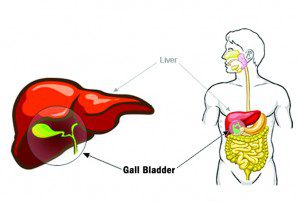By Peter M. Denk, MD, FACS


• Reduced pain at incision site(s)
• Reduced hospital stay
• Reduced recovery period
• Enhanced cosmetic healing
What is the Gallbladder?
The gallbladder is a sac located under the liver. It stores and concentrates bile produced in the liver. Bile aids in the digestion of fats, and is released from the gallbladder into the upper small intestine (duodenum) in response to food, especially fats. Over time the gallbladder may become diseased and it may be necessary to remove. Once the gallbladder is removed the bile will find other ways to reach the intestine.
Types of Gallbladder Disease Include:
Gallstones (Cholelithiasis) – Is the most common of all diseases with nearly 1 million new cases diagnosed each year. Gallstones are a stone-like substance. They can be as small as a grain of sand or as big as a golf ball. The bile contains water, cholesterol, fats, bile salt, proteins, and bilirubin. If the bile contains too much of some of these components, it can harden into gallstones. Symptoms of gallstones include:
• Pain, mostly in the upper right side of the abdomen
• Pain following meals, intolerance of fatty foods
• Nausea, vomiting
• Loss of appetite
An attack usually happens when a stone is blocking the passageway in the gallbladder. Women are at a higher risk of developing gallstones than men.
Inflammation of the Gallbladder (Cholecystitis) – Inflammation is most commonly due to obstruction of the cystic duct with gallstone(s). This blockage, also known as Choledocholithiasis, causes accumulation of bile in the gallbladder and increased pressure within the gallbladder. Concentrated bile, pressure, and sometimes bacterial infection irritate and damage the gallbladder wall, causing inflammation and swelling. Symptoms of an inflamed gallbladder include:
• Pain in the upper right abdomen
• Nausea, vomiting
• Fever
• Pain that gets worse during a deep breath
• Pain that lasts more than 6 hours, particularly after meals
Gallbladder dysfunction without gallstones:
Biliary dyskinesia is when the gallbladder is unable to contract properly or when the biliary ducts associated with the gallbladder are malfunctioning, thus preventing the gallbladder from emptying itself of bile. Symptoms can mimic other gallbladder disorders, especially upper right quadrant pain. This is just one of the things that can go wrong with the gallbladder where stones are not present.
Other possible symptoms of a gallbladder disease, in addition to those listed above, include:
• Indigestion
• Dizziness
• A feeling of fullness
• Diarrhea or soft stools
• Constipation
• Frequent headaches
What to do if you suspect a gallbladder problem?
The first thing you should do is to get a proper diagnosis. If your physician confirms your suspicion, there are ways to manage gallbladder disease without surgery as long as you don’t have an obstruction or infection caused by a gallstone. If surgery is necessary, there are many options available for patients.
Laparoscopic Surgery
GI Surgical Specialists is pleased to offer laparoscopic gallbladder removal, also known as laparoscopic Cholecystectomy. During surgery a thin, flexible tube known as a laparoscope is inserted through small incisions in the abdomen. Using a small camera and light in the laparoscope along with additional surgical tools, I perform the surgery while viewing the operation on a monitor in the operating room. Laparoscopic gallbladder removal surgery typically requires general anesthesia and usually lasts less than an hour.
Single-SiteTM daVinci® Surgery
GI Surgical Specialists also offers the Single-SiteTM daVinci® surgery for gallbladder removal. I am currently the only general surgeon in Lee County trained to offer this procedure. Many patients are candidates for this procedure, which eliminates the need for the several small incisions required by the laparoscopic technique. Single-SiteTM surgery uses the belly button as the only access site into the abdomen to perform the operation. By using only one incision site, you can further reduce your risk of surgical complications and recovery time while enjoying the benefits of no visible external scarring.
I invite you to visit our website today to learn more about my advanced training in Minimally Invasive Surgery and how GI Surgical Specialists can resolve your gallbladder disease.
GI Surgical Specialists
Ft Myers Office
13710 Metropolis Ave. #101
Fort Myers, FL 33912
Naples Office
8340 Collier Blvd. Suite 205
Naples, FL 34114
(239) 313-7522
GISurgical.com
 Southwest Florida's Health and Wellness Magazine Health and Wellness Articles
Southwest Florida's Health and Wellness Magazine Health and Wellness Articles

